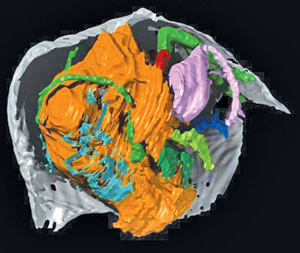|

Ancient fossil flea-like
creature found
Rare body parts provide vital clues to identity:
A geologist from the University of Leicester is part of a team that
has uncovered an ancient water flea-like creature from 425 million years
ago -- only the third of its kind ever to be discovered in ancient
rocks.
Professor David Siveter of the Department of Geology at the
University of Leicester worked with Professor Derek Siveter at the
Oxford University Museum of Natural
 History,
Professor Derek Briggs at Yale University USA and Dr Mark Sutton at
Imperial College to make the rare discovery.The specimen, which was
found in rocks in Herefordshire, represents a new species of ostracod,
and has been named Nasunaris flata. History,
Professor Derek Briggs at Yale University USA and Dr Mark Sutton at
Imperial College to make the rare discovery.The specimen, which was
found in rocks in Herefordshire, represents a new species of ostracod,
and has been named Nasunaris flata.
Like water-fleas and shrimps, ostracods belong to the group of
animals called crustacea. The find is important because the fossil has
been found with its soft parts preserved inside the shell.Today its
descendents are common, and inhabit ponds, rivers and lakes and many
parts of the seas and oceans, having first appeared on Earth about 500
million years ago.Geologists find ostracods useful in order to help
recreate past environments- the type of ostracod found in a rock sample
would, for example, help to determine a picture of ancient conditions
like water depth and salinity.
The study is published in the Proceedings of the Royal Society B. and
in Planet Earth, the online journal of the Natural Environment Research
Council.Professor David Siveter: "Most fossil ostracod species are known
only from their shells. You need exceptional conditions to preserve the
soft body- there are only two other known examples of ancient fossil
ostracods where the complete soft parts of the animal are preserved
along with the shell."Professor Siveter and colleagues were able to
identify the 5mm-long fossil, its body and appendages inside the shell,
including the antennae and also a set of paired eyes.The ostracod was so
well preserved that the team managed to spot the Bellonci organ, a
sensory structure observed in modern species which protrudes out of the
middle eye located at the front of the head.'This is the first time the
Bellonci organ is observed in fossil ostracods,' says David Siveter.Had
the soft body parts not been preserved, the scientists were likely to
misidentify the fossil based on the shell record alone, claims Professor
Siveter. –ScienceDaily
Sea lion pups
starving in California
Starved and emaciated(abnormally thin), sea lion pups are beaching
themselves along the Pacific Coast.A strong El Nino tropical weather
pattern is to blame.

Unusually warm sea surface temperatures in the western Pacific are
moving east, forcing the sea lions' natural food sources - squid, hake,
herring and anchovies to seek out cooler waters.
Adult sea lions have enough fat stored up to survive the resulting
food shortage, but their pups aren't so well-equipped. Richard Evans,
medical director of the Pacific Marine Mammal Center in Laguna Beach,
Calif., tells NPR's Guy Raz that by the time the animals get to his
team, they're in the third stage of starvation."We stage starvation in
humans and animals: one, two, three. Three is when you've gone so bad
that you start digesting your muscle as a source of protein."
The Pacific Marine Mammal Center rescues and nurses starving sea
lions back to health, and then releases them back into the sea.
Scientists at the centre started seeing an increase in starving sea
lion pups last spring.The centre sees sick animals all the time, but not
usually this severe.
The pups began coming in so sick that it took much longer to nurse
them back to health - up to six months instead of the usual two or
three.
Courtesy:Environmental News
Pen-pals
Name: F. Asheeka Zahra
Gender: Female
Age: 16
School: Baduriya Central
College, Mawanella
Hobbies: Collecting stamps
and stickers, reading novels and newspapers, operating the computer
Pen-pals preferred from:
Any country Age group: Any age Address: 115/A, Kirungedeniya, Mawanella,
Sri Lanka.
Name: S. A. Hansani
Lakmali Perera Gender: Female
Age: 16
Hobbies: Watching TV,
drawing pictures, reading novels, doing cross-stitch work, collecting
pictures School: Girls’ High School, Mt. Lavinia.
Pen-pals preferred from:
Any country
Age group: 16-20
Address: No. 102/81 A,
Puwakgass Watta, Nakandana, Madapatha, Sri Lanka. |

